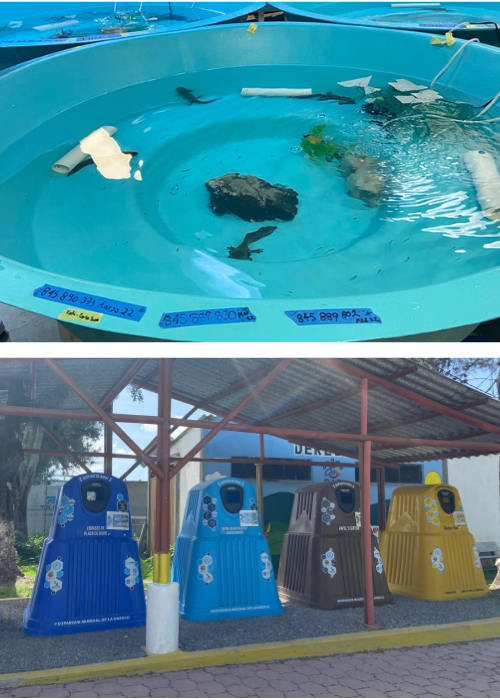
Conociendo nuestra cultura
Knowing our culture
From sea-level rise to drought, wildfires, and flooding, climate change’s effects are increasing worldwide. With a unique geography and many rural populations, Mexico—a place I hold dear to my heart—is especially vulnerable.
As a part of UC Berkeley’s Latinxs and the Environment Initiative, I had the opportunity to travel to Mexico City and Oaxaca for two weeks this summer to learn about agriculture, water management, and how rural communities adapt to climate change and preserve their cultural heritage. Conociendo Nuestra Cultura (Knowing Our Culture) is a bi-national program supported by UC AlianzaMX, an initiative that connects students from across all ten UC campuses with Mexico by providing funding for research collaboration, academic mobility, and other engagement activities. In the program’s first phase, I and nine other participants attended weekly lectures by researchers, government officials, and professors from UC Berkeley and UC Davis in June and July.

[image caption]
At the beginning of August, we traveled to Mexico City, where we heard from Dr. Luis Zambrano of the National Autonomous University of Mexico (UNAM) about analyzing Mexico City’s water crisis from an urban ecosystem perspective. We learned that groundwater over-pumping and continuous urbanization are causing the city to sink. Aquifers and reservoirs can’t recharge at the same rate of extraction, and many areas are experiencing flooding and a lack of drinking water. Xochimilco, a canal farming community, is one of the most impacted areas in the city, experiencing severe flooding and a scarcity of drinking water.

[image caption]
Through the Chinampa Shelter Project, “Refugio Chinampa,” Dr. Zambrano has worked alongside communities in Xochimilco to conserve chinampas and restore the ecosystem of the axolotl, a critically endangered paedomorphic salamander. Chinampas are wetland farming systems, consisting of small islands traditionally used for agriculture and linked together by networks of canals. The chinampas assist in recharging underground aquifers, regulate local and regional water flow, serve as a home for the axolotl, and hold cultural significance to the communities of Xochimilco. These efforts contribute to the fight against climate change by building more environmentally and socially sound communities, restoring the ecosystem in Xochimilco, and alleviating the water crisis in Mexico City.
We also visited the Geoparque Mundial Mixteca Alta, a geopark consisting of nine municipalities within the Mixteca Alta region of the state of Oaxaca. There, we were fortunate to learn from and interact with three rural communities: Santa María Chachoápam, Santa María Suchixtlán, and San Bartolo Soyaltepec. We heard about Santa María Chachoapan’s zero waste educational initiative, and how community members built dams and reservoirs to catch rainwater during periods of severe drought.
We also met farmers who are adapting by using drip irrigation and crop rotation to preserve water. Most farmers we encountered purchase hybrid seeds from large corporations or the government because they are more affordable than native criollo seeds. But seeds from the patented hybrid maize (corn) don’t grow if replanted, so farmers remain reliant on the corporations. They have also noticed that hybrid seeds do not grow as well in the varying terrains and temperatures of this region in Oaxaca, with little room for the ability to adapt to changes in climate or the land. One farmer who used native criollo seeds selected the maize with the best characteristics and was able to preserve seeds for the next season. Although most farmers rely on hybrid seeds, they aim to move toward using more criollo seeds, to have more sovereignty over their crops.
At UNAM-Oaxaca, we heard about maize diversity in Mexico from agroecologist and geographer Dr. Quetzalcóatl Orozco. Orozco told us about the evolution of maize’s ancestor, Teocintle, into what we think of as corn today, and how Indigenous communities around Mexico continue to conserve native corn.

[image caption]
Although I previously visited Mexico to see family in Jalisco, I had not visited Mexico City or Oaxaca. As a Mexican-American, first-generation, low-income student in academia, I never imagined I would have the chance to study abroad. Even more so, I never expected that I’d be able to study in a country so special to me—the land of my parents, grandparents, and ancestors. This experience allowed me to further connect my research on groundwater and agriculture to my identity, and to identify ways in which I can contribute to research and movements abroad.
Magaly Santos is a fourth-year student majoring in environmental economics and policy with minors in food systems and Geospatial Information Science and Technology. She has been a research fellow for the Latinx and the Environment Research Fellowship and is a communications assistant for Rausser College.
